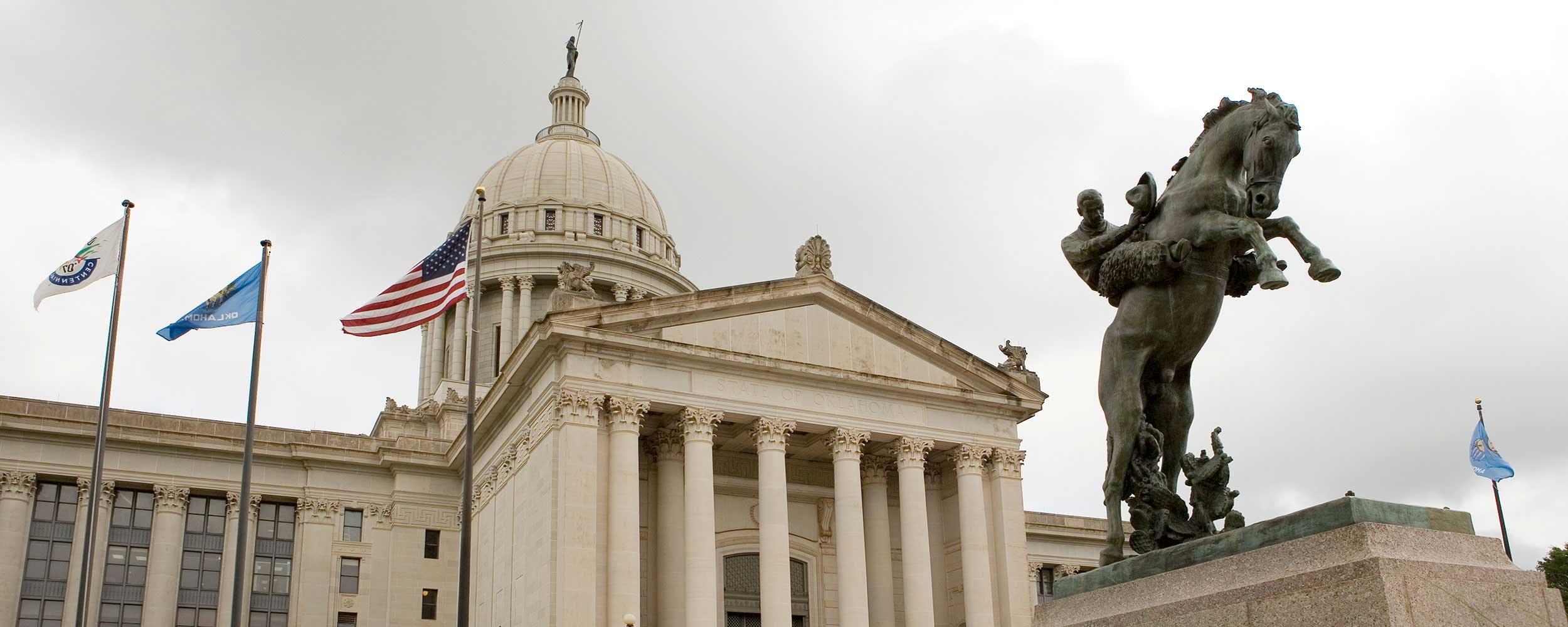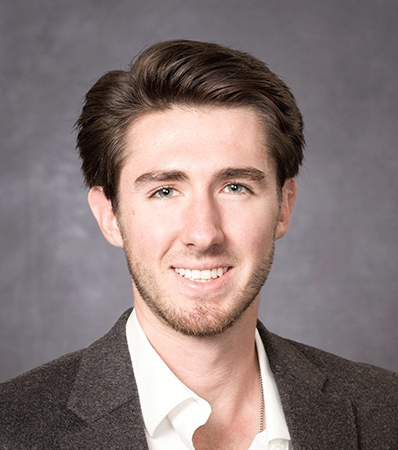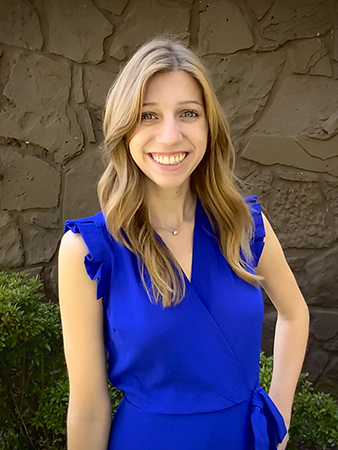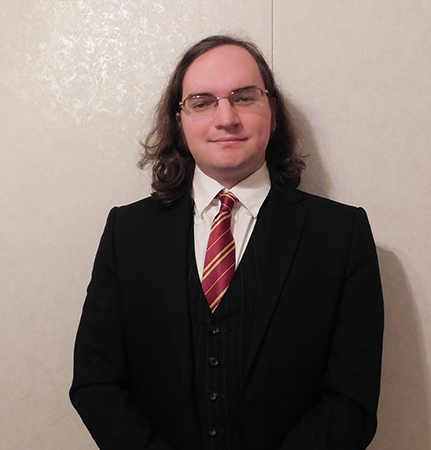
Three CAS students featured at Research Day at the Capitol
Tuesday, May 4, 2021
Media Contact: Jacob Longan | Coordinator of Communications and Marketing, College of Arts and Sciences | 405-744-7497 | jacob.longan@okstate.edu
Oklahoma legislators got a glimpse of the College of Arts and Sciences’ academic talent in March through three undergraduate researchers.
Aaron Austin, Sierra Posey and Sam Kauffman were invited to present their work at the Research Day at the Capitol in Oklahoma City, which is sponsored by Oklahoma’s Established Program to Stimulate Competitive Research (EPSCoR), Oklahoma State Regents for Higher Education and the National Science Foundation.
The annual event is meant to “inform the legislature and the public about the high-quality research being conducted at Oklahoma colleges and universities,” according to the EPSCoR website.
Austin, Posey and Kauffman, who represent the breadth of disciplines within CAS’s math and sciences pillar, recently answered questions about their work and experience participating in Research Day at the Capitol.
Aaron Austin of Edmond, Oklahoma, has OSU degrees in both Physics and Mathematics. His research with boron and carbon resulted in synthesizing a new material he and his fellow researchers named Boron Ortho-carborane Doped (BOD) Carbon. After submitting his work to the Research Day at the Capitol, he was awarded first place in the Research-Intensive Institution Category.
Can you explain your research as if talking to someone outside your field?
Our field of research is experimental condensed matter physics, which is definitely
a mouthful, but let me try and break it down. Basically, you can think of a condensed
matter physicist as a discoverer of novel/new materials and their properties. For
instance, we discovered a new carbon material that my presentation was based on, BOD
Carbon. Now as a condensed matter physicist, we chase numerous things like: How that
material grows; How it responds to light or electricity; What is its chemical composition,
and why does this make the material special?
There are many more questions we ask, but basically we want to figure out how we can use said materials and study them in a sound manner to find out any technological impact they may have.

What first prompted you to study the effects of boron on carbon? Were you anticipating
discovering or synthesizing a new mesoscopic carbon material?
In the past, my mentor and advisor had done work on a material called Boron Carbide.
This material has a wide range of applications. It is almost as hard as diamond and
can be readily synthesized. It is used in things like radiation shielding, bulletproof
vests and tank armor. We wanted to see if by taking an already known process for growing
graphite and adding boron to the reaction we could have a new way of synthesizing
boron carbide. Now as nothing is certain, we really did not know what to expect here.
We first theorized that this would lead to boron carbide, but out popped a new material
we had never seen before. We scoured the literature, but found nothing. We were very
excited that we had just made this new discovery and have mounted significant efforts
in studying the new material.
What was your favorite part of the research process?
I really enjoy the collaboration efforts that have come out of this project. Collaborating
is everything in research. Without it, not much can get done, especially in an experimental
setting. My other favorite part was the experiment leading to the growth of BOD Carbon.
The process we use — Atmospheric Chemical Vapor Deposition — has many variables that
determine the outcome of the experiment. Creating a fundamentally sound experiment
is very fun because when you accomplish your goal it is definitely fulfilling. It
also leaves plenty of room for mistakes to be made and corrected, and learning from
your mistakes is extremely valuable. And, to my point above, much collaboration goes
into many experiments, so I was able to be both the student and the mentor during
the process.
How could your research potentially be applied outside the lab?
So far, we have hypothesized (and proven to a degree) that BOD Carbon would be useful
in battery technology and hydrogen adsorption. The main takeaway is that we have shown
that the materials structure has the potential to be tuned to specific applications.
For instance, by engineering our structure we could make the ideal battery electrode
that could store energy very efficiently. Or for the case of hydrogen adsorption,
we can specifically tune the structure for maximum storage of hydrogen and efficiency.
Really, we have to do more research in order to prove our hypothesis. This also includes
theoretical modelling of the material.
You mentioned in your audio presentation that you received a provisional patent —
what exactly is being patented?
Basically, we have patented the material and the growth process, and subsequent technologies
that come from the material.
What does it mean to you and for your work to be recognized at the Capitol and with
the Research-Intensive Institution Category win?
First, I am extremely grateful to have been afforded the opportunity to present our
findings and to have been given the first-place prize. I consider myself extremely
lucky because it has been a joyful experience working on this project and collaborating
with my group. I absolutely cannot take all the credit though; I have had some of
the best mentoring you could ask for from Drs. David McIlroy and Elena Echeverria,
who supervised my project throughout its entirety.
It is really awesome that our research is getting recognized in these ways. It adds on to the positive image of Oklahoma State University and the Physics department. I am very glad I could help contribute to that image.
What's next for you?
Recently, I was accepted to the University of Toronto to pursue a Ph.D. in electrical
engineering. I start my journey there in August and am extremely excited to get that
underway. Until then, I will be in Stillwater continuing research in Dr. McIlroy’s Research Group in the OSU Department of Physics.
Sierra Posey from Coweta, Oklahoma, is set to graduate in Microbiology/Cell and Molecular Biology with a minor in Religious Studies. In addition to her research being featured at the Capitol, she finished second in the Research-Intensive Institution Category.
Did you come to OSU knowing you wanted to study Microbiology and Molecular Genetics?
I actually came to OSU as a chemistry major, then changed to physiology. My first
semester I began working in Dr. Karen Wozniak’s microbiology lab and became interested in microbiology and immunology. This is mainly due to Dr. Wozniak
having me read research papers. She would spend a lot of time answering all the questions
I could have and helped fuel my interests in microbiology. I decided after my first
semester that I wanted to be a microbiologist and be a part of the amazing microbiology
department here on campus.

Can you briefly explain your research on Cryptococcus neoformans, the leading cause
of fungal meningitis?
Basically, our immune system is meant to fight and kill the bacteria and fungi that
invade our body. With Cryptococcus neoformans, however, it is able to take over our
immune cells that are supposed to phagocytize, or ingest, C. neoformans. C. neoformans
is able to work around our immune cells, and so my research is studying the proteins
in our immune cells — in my case, the dendritic cell — to better understand the mechanisms
of C. neoformans. So far we have identified several lysosomal proteins that have antifungal
activity, but there are also lysosomal proteins in our dendritic cells that actually
help C. neoformans grow. We are still trying to understand why that is.
What first prompted you to research C. neoformans?
I have been studying this since my freshman year. Dr. Wozniak in previous labs was
able to identify the lysosomal proteins in a dendritic cell by using mass spectroscopy,
and so she had us all start by testing individual proteins with C. neoformans. From
there we would have another question and I would test it.
Did any of your findings surprise you?
It has been interesting to see how not all of our lysosomal proteins have antifungal
activity and some proteins actually help C. neoformans grow.
What was your favorite part of the research process?
My favorite part of this research project has been getting to test ideas, ask questions,
and test them. I am a senior this year and will be concluding my research in the Wozniak
Lab, but I am leaving having so many questions answered — but I also have so many
new questions. That is exciting to me.
How could your research potentially be applied outside the lab?
We are hoping that someday the research we are doing now will help create a better
drug therapy for people who are infected with C. neoformans and have cryptococcal
meningitis.
What's next for you?
This fall I will be attending the OSU College of Osteopathic Medicine at the Cherokee
Nation in Tahlequah. I hope to have another opportunity to work in a lab and develop
more scientific skills.
It is such an honor to get to be a part of symposiums and share the work I am a part of. I felt proud that I had the chance to share the importance of C. neoformans with Oklahoma legislators. Getting to be a part of the Wozniak Lab has been such a privilege and I am glad I have had the chance to learn from Dr. Wozniak for the past four years. It is so awesome being a part of the research community!
Sam Kauffman was born and raised in Tulsa, coming to OSU to earn his degree in Computer Science. While he has been involved with STEM subjects in the past, he “only recently delved into VR development,” which led to his research being recognized at the Capitol as well as a recent KFOR news spot.
Can you briefly explain your research?
My research project involves creating virtual reality environments for a variety of
uses. These environments use VR headsets and controllers to teach nurses about properly
handling Personal Protective Equipment (PPE) like masks and face shields, taking COVID
swab samples, and hooking up a patient to a ventilator. All of these steps are important
for stopping the spread of COVID-19 while treating infected and potentially infected
patients.

What first prompted you to study VR and Human Centered Computing (HCC)?
I took Dr. Blayne Mayfield’s course on Mixed Reality Development my junior year, and
it really sparked an interest in VR development. As with most things, it just seemed
very out of reach until I finally tried it. When Dr. Mayfield notified the class that
the Center for Cyber Physical Systems on campus had available positions, I applied
immediately.
Were you involved with HCC or VR before COVID-19, or was it the pandemic that got
you involved?
I was introduced to HCC when I joined the center, but had previous VR experience from
classes and what I had seen online. The first time I used a VR headset was during
a tech showcase freshman year, where the library let students take turns playing a
tech demo. Although I didn’t see much VR from that point until my work at the lab,
I was open to the possibility of VR development in the future.
Did you help create the VR in addition to conducting the research with it?
I was the main developer for the VR environment, including the 3D modeling and programming,
animation and environment design. The simulation was made with help from local and
out of state nurses in Arizona, with the intent to create a realistic and efficient
training scenario. I’ve had a few other students in the lab help me, but when the
project started it was myself and another student. He left the lab earlier in the
project, however, so I made most of the changes visible in the current product.
How was it working with test subjects out of state?
It was interesting to see how hospitals out of state handle COVID prevention procedure,
especially in a place like Arizona. During our trips we saw a variety of medical professionals,
from nurse trainees to experienced doctors, all eager to practice and train with our
simulator.
What was your favorite part of this research process?
Definitely the hands-on learning aspect. I went in with very little knowledge of VR
programming or development experience, but learned a lot about both as the project
needed it.
Were you surprised by any of the results?
I was incredibly surprised at how quickly older participants acclimated to the VR
experience. There’s a sort of stereotype about older folks having a hard time with
VR, but they were impressed immediately and got used to the new environment at a similar
rate to the younger nurse trainees.
How else could your research be applied? Does it have applications outside of the
medical field?
Absolutely. There are already applications of Mixed Reality in training for a variety
of fields, even adjacent medical fields such as patient rehabilitation and therapy.
The limits of VR are partially due to the current state of available technology, but
there is great potential for use in artistic projects, in architecture and design,
and in telepresence communication. The list goes on, and since a virtual environment
can simulate close to anything, the applications are likewise endless.
What does it mean to you and for your work to be recognized at the Research Day at
the Capitol?
It’s an incredible honor to be recognized, especially by our state representatives.
Knowing that our legislators have an interest in supporting and understanding new
research and the potential benefits for our state is a welcoming feeling.
What's next for you?
As with most things, there is always more to be done. When I graduate, the research
project will be in the hands of my fellow students, who will be making improvements
to the simulation and the experiment process. As for my career, I think there’s a
lot to be done in the field of VR development. I’ve always enjoyed the creative side
of computer science — building programs to make technology more accessible to more
people. I may not be on the research side, but I can definitely offer my services
as a developer. OSU, and the lab in general, has been a great learning experience
for me. I’ve had the freedom to apply myself in the fields that I enjoy and find interest
in, and can picture myself combining my hobbies with my skills in the future.
Story By: Elizabeth Gosney | egosney@okstate.edu
